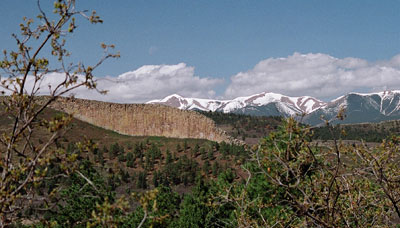 Lathrop State Park, with 1,594 land acres, features two reservoirs (Horseshoe and Martin), covering 320 surface-acres. The water bodies are filled from the Cucharas River, which flows from the nearby mountains through the foothills and mesas of the area. The Walsen Ridge, or Hogback, an ultrabasic dike formed during volcanic activity in the Eocene and Oligocene periods, is located along the northern boundary of the park.
Lathrop State Park, with 1,594 land acres, features two reservoirs (Horseshoe and Martin), covering 320 surface-acres. The water bodies are filled from the Cucharas River, which flows from the nearby mountains through the foothills and mesas of the area. The Walsen Ridge, or Hogback, an ultrabasic dike formed during volcanic activity in the Eocene and Oligocene periods, is located along the northern boundary of the park.
Lathrop is overlooked by the geologic attractions, the Spanish Peaks and the Sangre De Cristo Mountains. The Spanish Peaks are unique because they were not formed in the same way that the faulted and uplifted Sangre de Cristo Mountains were. They are prime examples of “stocks,” which are large masses of igneous (molten) rock, that intruded layers of sedimentary rock and were later exposed by erosion.

Big Wall looking west towards the Culebra Range from CR-363
Image courtesy of Jonathan D Kelly.
Among the most unusual features of the peaks are the great dikes which radiate out from the mountains like spokes of a wheel. The dikes are made of intrusive igneous rock that squeezed its way into the cracks in the sedimentary rock, like mud between a child’s toes. Erosion wore away the softer sedimentaries, leaving walls of hard rock from 1 foot to 110 feet wide, up to spectacular heights of 100 feet, and as long as 14 miles. Geologists come from all over the world to view these dikes and have identified over 400 of them.

